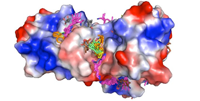Structure Prediction and Design

[Click Image to Enlarge]
Disembodied "Hot Spot" residue map of Influenza hemagglutinin depicting amino acids docked to the surface of the protein--a first step in designing binders to disrupt function.
The structures of many biological assemblies are not readily amenable
to traditional x-ray crystallographic structure determination methods because they cannot be crystallized. Most
assemblies are also too large for conventional NMR structure determination methods. Lower resolution methods can
provide valuable structural information, but deriving accurate all atom models from such data is a significant
challenge. We are developing computational methods for generating reliable models from limited experimental data.
Types of experimental data include: distance constraints provided by MS-crosslinking (described above), distance
constraints provided by FRET (described above) and cryo-electron microscopy data. NMR data and x-ray crystallographic
data can also be incorporated when available.
We are also developing methodology for computationally designing proteins that specifically bind to an arbitrarily chosen
protein surface patch. This is an unsolved problem with very broad potential applications in molecular cell biology,
therapeutics, and diagnostics. Given a target surface patch on a protein of known structure, we begin by docking
disembodied amino acid sidechains against the surface to identify crevices and pockets where favorable sidechain-target
protein interactions can be made. Next, we search through a large set of stable protein scaffolds for one that can
position these "hotspot" interacting residues in the proper orientation for binding, while at the same time having
global shape complementarity with the target protein. Finally, we use the standard Rosetta (for a description of
Rosetta, click here) protein design methodology to optimize the remaining residues at the interface to maximize
the predicted target protein binding affinity. We are looking for collaborations to design specific binding partners
to proteins of known structure.